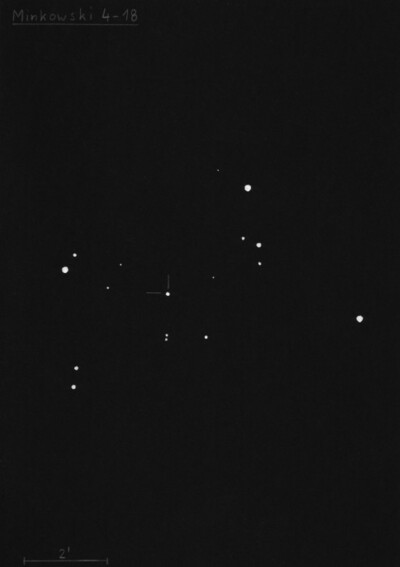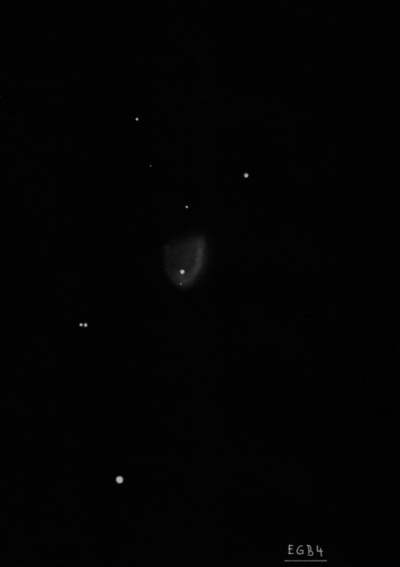A large but very faint constellation in the northern sky that never sets in our latitudes. It lies in an almost starless region, in the space between Cepheus, Cassiopeia, Perseus, Auriga, Lynx, Draco, and the star Polaris of the Little Bear. It is almost impossible to make out the cluster of faint but actually very distant and very bright stars without a good map. Although this constellation occupies a fairly large area and its southeastern boundary extends slightly into the Milky Way, it contains only four stars brighter than 4.5 mag. However, this faint region harbours several nice open clusters (NGC 1502), a relatively bright galaxy (NGC 2403), a nice planetary nebula (NGC 1501) and an exceptional cluster of stars known as the Kemble Cascade.
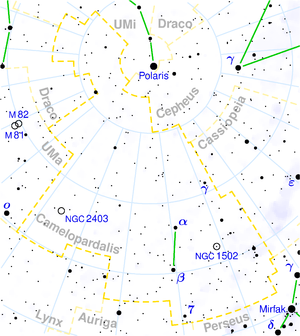
β Cam - The brightest star of the constellation has an apparent magnitude of 4.22. This yellow supergiant of spectral class G0 is located 870 light-years away and shines 1,600 times brighter than our Sun. The surface temperature reaches 30,000 Kelvin.
α Cam - In the sky, it appears as a 4.3 magnitude star. However, in reality, this blue supergiant of spectral class O is 620,000 times brighter than the Sun. It is located approximately 6,000 thousand light-years away from us.
VZ Cam - A semi-regular variable star of type M, when observed through a telescope, appears noticeably red. It exhibits small, irregular changes in magnitude, ranging from 4.8mag to 5.2mag with an average period of about 24 days. Due to its proximity to the celestial pole, it can be observed throughout the year from more northern latitudes.
29 Cam - A binary star suitable for a 100mm telescope. That it is a binary star is evident at 100x magnification. It appears as an unequal (6.5mag, 9.5mag) and contrasting pair of yellow and pale blue components. Their mutual distance is 25.1".
Z Cam - A cataclysmic variable star, which jumps every two to three weeks from a minimum around 13mag to a maximum with a magnitude of 9.6mag. However, its similarity to other variable stars of this type ends there. Its magnitude can actually stop decreasing and remain at a medium brightness level for a very long time. It stays like this for several months before its magnitude starts increasing again - the star is therefore weakening.
NGC 2403
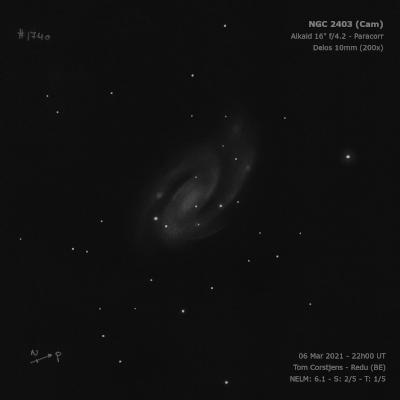
William Herschel discovered NGC 2403 = H V-44 on 1 Nov 1788 (sweep 879) and recorded "cB; R; vgbM; BN; 6 or 7' dia; resembling a star with a misty atmosphere." His summary description, also based on a later observation, states "with a faint branch extending a great way to the np side; not less than 1/2 degree; and to the n or nf the nebulosity diffused over a space, I am pretty sure, not less than a whole degree." Obviously, his size estimate is well off, but his description of a "faint branch extending a great way to the np side" applies to the spiral side on the west side and the comment "to the n or nf the nebulosity is diffused over a space" probably applies to the northern arm that extends to the east (and contains NGC 2404).
Based on photographs taken with the 60-inch reflector at Mt Wilson, Francis Pease (1917) remarked "This fine right-handed spiral nebula resembles M33...Faint knots and arms extend as far as 10' from the center. It does not contains the wealth of detail of M33, but has the same sharp stellar images, the nebulous stars [HII regions], the bunching of these knots and the dark streaks.."
200/250mm - 8" (1/1/84): bright, large, bright core, faint star superimposed, mottled?
300/350mm - 13.1" (1/11/86): spiral arm definite on the west side of the galaxy with a dark gap between this arm and the main body (core). This feature is very faint but definite with averted.
13.1" (12/22/84): spiral arm highly suspected attached at the west side winding along the north side to a faint knot = NGC 2404.
13.1" (1/28/84): very bright, large bright core. NGC 2404 is clearly visible as a faint, very small nebulous knot along the east side of the galaxy. Spiral structure (arms) is just suspected. On 3/24/84 the knot was difficult to view at 144x, but on 1/11/86 was fairly easy.
400/500mm - 17.5" (2/28/87): very bright, very large, bright core, elongated 5:2 NW-SE, 15'x6'. Impressive galaxy with spiral structure clearly visible. Two spiral arms are attached at opposite ends of the central region and both wind almost 180°. The tip of the northern arm ends at the emission nebula NGC 2404. Several stars are superimposed including two mag 11 stars.
17.5" (2/22/87): two spiral arms are visible on attached at the opposite sides of the galaxy and winding a half of revolution. The northern arm ends at the HII knot NGC 2404. The galaxy has a mottled appearance.
900/1200mm - 48" (4/15/10): this amazing multi-arm spiral stretched across the entire 15' field at 330x, with the major axis running NW to SE. A striking prominent spiral arm is attached near the NW end and sweeps counter-clockwise 180° along the northern side of the galaxy, tapering as it extends to a point roughly 5' SE of the core. The arm is widest near the NW end, where it begins sweeping east. A second inner arm attaches near the SE end of the main body and tightly hugs the southern side of the galaxy as sweeps to the NW side. A more ill-defined branch heads west from the SE end past a mag 11 star situated 2' WSW of the core. The field was too small to trace out the outer arms. Numerous HII splotches stained the surface and I only had time to quickly sketch the most obvious knots.
The supergiant HII complex NGC 2404 located 1.7' ENE of the core and 1.5' NNW of a superimposed mag 10.5 star, appeared as a very bright, irregular, 20" knot. Hodge lists NGC 2404 as A67 in his 1985 paper "Stellar Associations in the Galaxy NGC 2403". On the NW side of the galaxy is a collinear string of 3 stars oriented NE to SW with an obvious collinear knot an additional 50" SW (SPC-44 in Sivan, Petit and Comte's 1990 "Optical HII Regions in NGC 2403"; VS 3 in Véron and Sauvayre; and A14 in Hodge). Just north of the core are two HII knots, separated by 45" and both 12" in size. The western knot is catalogued as SPC-174 = VS 24 = A36 and the eastern knot as SPC-224 = VS 38 = A45 .
On the SE side of the galaxy is a pair of HII knots separated by 40". The eastern knot is SP-346 = VS 51 = A80 and is situated 1.6' SE of the mag 10.5 star and the western knot includes SPC-318/321/322. At the SE end of the spiral arm that contains NGC 2404 is another 10" knot, which includes SPC-348/351/352 = VS 52 = A81. It can be pinpointed 1.0' NE of the mag 10.5 star. On the SE end of the galaxy a fairly faint, irregular knot (SPC-331/336/343 = VS 48/49 = A73) was noticed 1' W of a mag 14 star.
Notes by Steve Gottlieb
NGC 1502
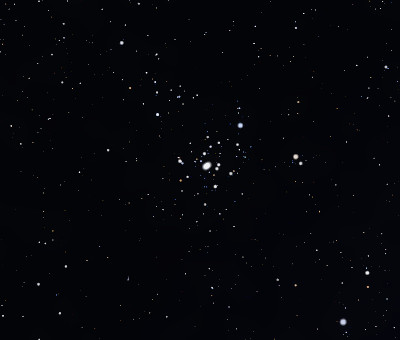
William Herschel discovered NGC 1502 = H VII-47 on 3 Nov 1787 (sweep 774) and recorded "a cluster of stars, pretty rich and considerably compressed, slightly extended, 3' or 4' diameter, irregular figure."
300/350mm - 13.1" (1/28/84): bright, striking cluster, 40 stars visible in a trapezoidal outline. The brightest is the striking double STF 485 = 7.0/7.1 at 18" and the cluster also includes ?484 = 9.0/9.5 at 5". NGC 1502 is located near the SE end of the chain of stars "Kemble's Cascade". The cluster, part of the Camelopardalis OB1 association, contains 17 type-B0 to B3 stars.
Notes by Steve Gottlieb
IC 342
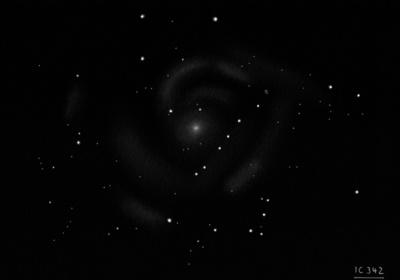
E.E. Barnard discovered IC 342 on 11 Aug 1890 with the 12-inch refractor at Lick Observatory. He sketched it at 150x as well as 500x and noted, "with 500x it is quite a bright object, 1/2' dia and quite [?], mbM, not cometary. Object 1' S of this star [shown on sketch] and following 3 or 4 seconds." His rough position and sketch (showing the superimposed linear strings of stars) is an excellent match.
William Denning independently discovered IC 342 on 19 Aug 1892 while comet hunting with his 10-inch reflector. The discovery was announced in a short note, "New nebula", Astronomy and Astro-Physics, 12, 189 (1893). He called it "rather faint, with nucleus about 12th magnitude, and very small, but it was sufficiently conspicuous to be discovered with a power of 40 only on my 10-inch reflector." As Barnard never published his discovery or informed Dreyer, Denning was credited with the discovery in the IC.
In a note by Hubble and Seyfert titled "A Spiral Nebula of Unusually Large Dimensions" (Harvard College Observatory Bulletin No. 899, pp.16-17): "In a letter written to Dr. J. L. Dreyer before 1894, Mr. W. F. Denning, the well known meteor observer of Bristol, included in a short list of new nebulae an object in the position 3h 37m 8s, +67d 46.9' (1900), which was simply described as "pretty bright, very small, star of 12th magnitude close to nucleus."
Hubble and Humason (1934), first recognized this object as a spiral galaxy and suggested it was possibly a Local Group member (heavily reddened) based on its recessional velocity, though it was later shown to be too distant. IC 342 is one of the brightest members of the IC 342/Maffei Group that includes NGC 1560, NGC 1569 and highly obscured Maffei I and 2.
200/250mm - 8" (3/21/20): the small core/nucleus was very noticeable, as well as a very large, roundish outer halo ~15' diameter with a diaphanous appearance. The halo seemed to fill in the gaps between the numerous surrounding stars.
8" (10/13/81): very faint, large, very diffuse outer halo, very small prominent 12th magnitude nucleus. A line of three stars is superimposed.
300/350mm - 13.1" (1/18/85): at 144x the nucleus is prominent as a mag 12 "fuzzy" star. At this power the outer halo disappears.
400/500mm - 17.5" (12/16/95): very unusual galaxy, appears as a very faint, very large glow surrounding a 1' high surface brightness core that increases to a bright stellar nucleus. The irregular halo is difficult to trace but extends to ~10' diameter with a number of superimposed stars including a striking 6' string of six mag 10.5-12.5 stars oriented NW-SE on the southwest side of the halo. No arm structure was seen. The core forms a small triangle with two similar superimposed mag 11 stars 1.0' N and 2.0' NE. Situated just 10.6° above the galactic plane and suffers from significant dust obscuration.
600/800mm - 24" (3/21/20): at 124x and 200x; this obscured galaxy contained a very bright 30" nucleus that gradually increased to a sharp stellar point. The nucleus was surrounded by a fairly faint core/central region with a diameter of at least 1'. A 12th mag star is just 1' N of the nucleus. This star is the middle of 3 nearly in a line with a mag 12 star 2' E and a mag 11 star 2.5' WSW. A very diffuse halo of low but irregular surface brightness extends ~15', best viewed at 124x. A distinctive string of 6 stars oriented NW-SE cuts across the halo to the southwest of the nucleus. Spiral arm structure was very subtle and only seen in patches or sections, one on the north side, roughly 5' from the core.
UGC 2826, located 21' NW, appeared fairly faint, elongated 3:2 NW-SE, ~0.6'x0.4', low but uneven surface brightness, weak concentration.
Notes by Steve Gottlieb
NGC 1501
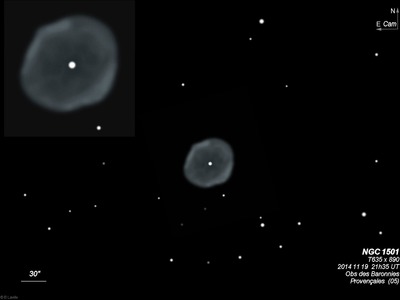
William Herschel discovered NGC 1501 = H IV-53 on 3 Nov 1787 (sweep 774) using the front-view (no secondary) design with a power of 157. He described "a very curious planetary nebula of nearly 1' in diameter; it is round, pretty well defined of a uniform light and pretty bright." Just 6 nights later, he reported "with 360 much magnitified, but still the borders pretty abruptly defined, irregularly elliptical." John Herschel didn't report an observation.
On 15 Jan 1868 Lawrence Parsons, the son of Lord Rosse, reported "a bright ring and inside it a dark annulus, very decided. A star in the centre seen very clearly and continuously with various powers; suspect variable [unequal?] brightness in the ring, perhaps a dark spot in it nearly on the p side. The f side of the ring appears broadest and to approach the central star nearer than the preceding side does. The n and s sides of the ring seem rather brighter than the p and f sides. Suspect other bright points in it, but am not at all certain. It is slightly elliptical, its major axis being nearly p and f."
Based on a Crossley photograph, Curtis (1918) described, "central star nearly mag 12, surrounded by a very irregular and patchy elliptical disk, about 56"x48" in pa 98?. The periphery shows traces of a broken ring formation the brightest portions are the edges at the ends of the minor axis."
On a 60-inch Mt Wilson photograph, Pease (1917) reported "this is a fine planetary of regular elliptical shape, 60"x45", p.a. 120?, with protuberances at each end of the minor axis making a total breadth 53". The nebula is irregularly mottled, bearing a resemblance to the convolutions of the brain."
200/250mm - 8" fairly faint, moderately large, bluish, slightly elongated, sharp-edged.
300/350mm - 13.1" (1/28/84): slightly annular, very faint mag 14 central star visible.
400/500mm - 17.5" (1/8/00): at 100x, this moderately bright PN was irregularly round, 1' diameter, weakly annular with a faint glimpse of the central star. There was a good contrast gain with the OIII filter and the image was crisp-edged, slightly elongated SW-NE and the small, darker center was more evident. Excellent view at 220x with the faint central star (mag 14.4) clearly visible. The surface brightness was irregular with an unevenly brighter outer rim. The central star was visible steadily at 280x and the overall surface brightness was mottled or "clumpy" (brighter on west and NE rim), darkening in the center.
17.5" (9/14/85): bright, moderately large, almost round, 1' diameter, high surface brightness. An easy mag 14.2 central star is visible. Appears darker near the central star with a brighter rim.
Notes by Steve Gottlieb
NGC 1569
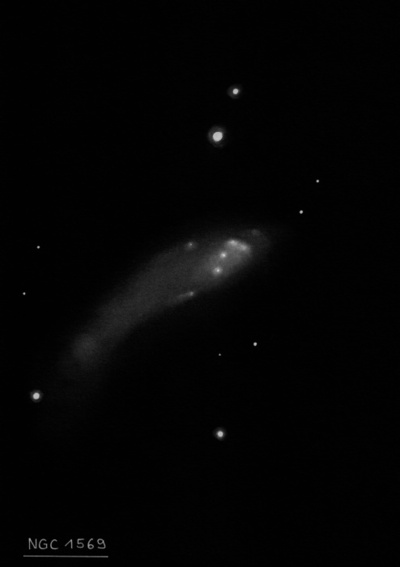
William Herschel discovered NGC 1569 = H II-768 on 4 Nov 1788 (sweep 881) and noted "pB, S, lE, BN, just south of a pretty bright star." Ralph Copeland observed this galaxy on 17 Jan 1873 using Lord Rosse's 72" and recorded, "Decidedly cometic in appearance, with the head north-preceding. Position of elongation 111.2?. Has an 11 mag reddish star in PA 359?, Dist 45". This star is the south member of a double star. There is also a 15m star following in the direction of the axis of the nebula. This object, although of the second class, is 3 or 4x as bright as H I-258 [NGC 1491]."
200/250mm - 8" (11/28/81): fairly bright, small, elongated. Located just south of a mag 9 star.
300/350mm - 13.1" (1/18/85): very bright, elongated 2:1 WNW-ESE, high surface brightness, elongated bright core, mottling suspected. Located just 1' S of a mag 10 star.
400/500mm - 17.5" (3/1/03): at 380x this is a bright, very elongated galaxy with an unusual asymmetric appearance, situated less than 1' S of a mag 9.5 star! Extended nearly 5:2 NW-SE, 2.0'x0.8'. The bright core is offset to the NW side of the glow with a tail extending SE, possibly bending at a slight angle to the core. Two stellar "nuclei" are visible in good seeing. The brighter "star" is embedded within the core, possibly just slightly north of center. A second fainter "star" is close SE, near the edge of the core and is visible intermittently. These "stars" are actually SSC's (luminous super-star clusters). NGC 1569 was recently determined to be a member of the IC 342 galaxy group.
17.5" (1/12/02): very bright, elongated 5:2 WNW-ESE, 2.5'x1.1', high but irregular surface brightness with an asymmetric appearance. The very bright core is mottled and irregular and is offset to the NW side of the galaxy! At 380x, there are two stellar "nuclei" within this glow. The brighter stellar nucleus is fairly easy and a fainter stellar point is close SE. There is also a strong impression of a third stellar spot close west of the central nucleus. These faint "stars" are actually luminous super-star clusters, the most massive known type of star clusters (color image at http://www.lowell.edu/users/dah/papers/n1569hst.html). A mag 10 star is close off the north side, 1' from center and a mag 13 star is just off the SE end.
900/1200mm - 48" (10/23/11): at 488x, three very compact knots (luminous super-star clusters) were closely lined up from NW to SE in the central region (total length ~15") with the brightest knot NGC 1569-A in the middle of the trio. NGC 1569-A was flanked by 1569-C 7" NW and 1569-B 7" SE. NGC 1569-C appeared very small but was also clearly non-stellar. NGC 1569-B, very close to the geometric center, was very compact and symmetrical, like a slightly bloated star. SIMBAD lists a V mag of 15.3 for 1569-A.
Notes by Steve Gottlieb
UGC 3697
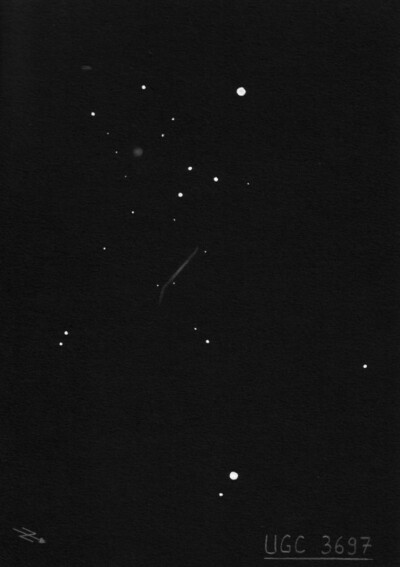
400/500mm - 17.5" (3/16/96): the "Integral Sign" galaxy appears as a very faint, extremely thin ghostly streak oriented WSW-ENE, at least 2.5'x0.3'. Low surface brightness with no significant concentration. The curved tips were not seen. Difficult at 100x but shows up well at 220x. Forms a pair with moderately bright UGC 3714 7.6' SE.
600/800mm - 24" (2/5/13): at 125x the Integral Sign Galaxy was easily visible just south of a line connecting mag 6.4 HD 54070 12' ESE and mag 7.0 HD 52762 13' NW. At 375x the galaxy extends 2.2'x0.2' (~12:1) ~E-W. The galaxy has a fairly even surface brightness with just a slightly brighter core, though fades on the west end as it bends or hooks towards the north. This extension has a very low surface brightness. 1' off the east end is a mag 14.5 star. A fainter mag 15.5 is close south on the west side at the point where the galaxy bends north and dims. No structure or bending was seen on the east end and the brightness falls off rapidly at the tip.
900/1200mm - 48" (4/13/10): The Integral Sign galaxy was carefully observed at 510x. This super-thin galaxy extended 3.3'x0.15' E-W for roughly a 20:1 axial ratio! Near the west end of the galaxy there is a noticeable hook towards the northwest as the galaxy fades and ends at a very faint star or knot [there is an extremely small HII knot at the NW tip]. The low surface brightness portion near the west end has an irregular, streaky appearance with the impression of knotty structure near the tip. The eastern end has a much more gradual, subtle bending so that the eastern tip is pointing due east, although the central portion of the galaxy is oriented WSW-ENE. A mag 16 star is just off the north side, slightly west of center and a mag 15.5 star is off the south side where the hook begins on the western side.
Notes by Steve Gottlieb
NGC 2655
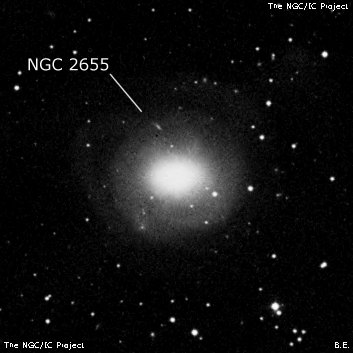
William Herschel discovered NGC 2655 = H I-288 = h520 on 26 Sep 1802 (sweep 1111, his second to last sweep) and recorded "vB, cL, lE, suddenly mbM. I suspect it to be a cl of star." CH's reduced position is 5' north of UGC 5152. On 21 Aug 1828 (sweep 170), John Herschel wrote, "vB; lE; in parallel; psmbM, to a nucl = a * 12m; 30". Has a L * p and another f, at a considerable distance." Horace Tuttle independently found the galaxy on 8 Apr 1850 with the 15-inch Merz refractor at the Harvard College Observatory and it was reported as HC 12 in the AN #1453 discovery list. The HCO position is accurate.
According to Michael Hoskin's "Unfinished Business: William Herschel’s Sweeps for Nebulae", NGC 2655 = H I-288, NGC 2908 = H III-977 and NGC 3057 = H III-978 were the last three entries in his third catalogue to officially bring the total to 500 -- added after Herschel's third catalogue had been sent to the Royal Society for publication in 1802. A month after submission, Caroline discovered that only 497 objects were included and on 26 Sep 1802, Herschel found 6 new nebulae. Three of these (including NGC 2655) were added by Caroline to the catalogue, and three were saved for a possible additional catalogue. A few nights later (30 Sep 1802) WH discovered 4 more nebulae but these along with 3 from earlier years that were overlooked were added at the last minute to the proofs to bring the actual total to 510, as WH was finished with his sweeps.
400/500mm - 17.5" (2/1/92): very bright, moderately large, elongated 3:2 E-W, 3'x2', even concentration to an unusually bright core and almost stellar nucleus. There appears to be a sharper light cut-off along the north side. Forms an equilateral triangle with mag 9.2 SAO 6687 10' NE and mag 7.4 SAO 6692 11' SE. Brightest in a group (LGG 165) including NGC 2591, 2715 and 2748.
600/800mm - 24" (3/21/20): at 260x; very bright, very large, slightly elongated 5:4 E-W, at least 4' x 3.2' and perhaps larger (outer periphery very diffuse), very strong concentration with an unusually bright core and an intense nucleus. At 375x, the nucleus increases to a a confused stellar peak. Two stars are superimposed on the southwest side; one near the edge of the core region and the second inside the fainter outer halo.
Notes by Steve Gottlieb
NGC 2336
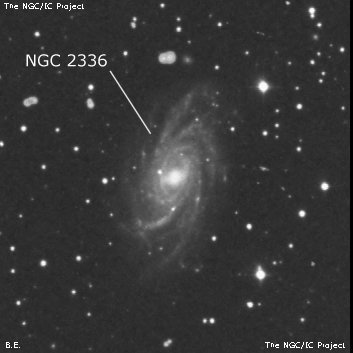
Wilhelm Tempel discovered NGC 2336 = T I-22 in 1876 with the 11" refractor at the Arcetri Observatory and described a "beautiful II class nebula, R, lbM, 2' diameter, forms a triangle with two mag 10-11 stars." Tempel's very rough position (only the hour of RA is given!) is off by 2.5 tmin of RA (west) and 3' dec (north) and the two stars in the description are just north.
400/500mm - 17.5" (8/27/87): fairly bright, fairly large, bright core, faint halo elongated N-S. A mag 15 star is superimposed just east of the core. Located 3.6' SSE of a mag 10 star. IC 467 lies 20' SSE. A mag 14.7 supernova discovered in 1987 by Dana Patchick was observed (1987L).
17.5" (2/22/87): fairly bright, small bright core surrounded by a large, diffuse halo elongated 2:1 N-S. Located 26' S of a mag 7.3 star.
Notes by Steve Gottlieb
NGC 2146
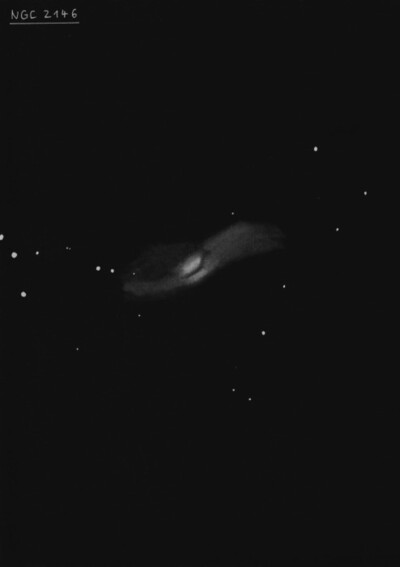
Friedrich August Winnecke discovered NGC 2146 = T 1-18 in 1876 using a 6.5-inch comet seeker at the Strasbourg Observatory. It was independently discovered by Wilhelm Tempel the same year and by Johann Palisa (AN 2732). This is one of 3 galaxies discovered by Winnecke, along with NGC 2276 and NGC 4760. In 1920, based on a photograph taken with the Mt. Wilson 60", Francis Pease described "the nucleus lies a little S of the center of this mass; the nebulosity is brightest around the nucleus. Superimposed on this bright mass is a dark marking in the form of a hand, with four talon-like figers stretching south-preceding and with three stars standing out upon it." This must be the source of the nickname "Dusty Hand Galaxy".
As there is no candidate for a previous interaction (creating the disrupted appearance and nuclear starburst), it has been proposed that NGC 2146 is a far-evolved merger.
300/350mm - 13.1" (1/18/85): fairly bright, fairly large, very elongated 3:1 NW-SE, bright core. A mag 11 double at 30" separation is just off the SE end. A few brighter mag 10-11 stars are 6' E. NGC 2146A lies 19' ENE.
600/800mm - 24" (12/28/13): this highly distorted galaxy was observed at 260x. The galaxy appeared very bright, very large, elongated 5:2 NW-SE, ~5'x2', with a very asymmetric structure. It contains a very bright, elongated core, ~1.2'x0.5' NW-SE, but with no distinct nucleus. A low contrast dust lane cuts through the core unevenly, with the main section on the north side, so the lane initially appears to run parallel to the core on the southwest side. But a fainter, elongated section of the core extending NW-SE is just beyond the dust lane on the southwest side. To the southeast of the core, the outer halo is diffuse, with a low surface brightness and is not aligned with the major axis of the core, extending more towards the east. On the NW side of the core, the halo has a higher and irregular surface brightness with a slightly brighter curving arc (arm) along its eastern side.
900/1200mm - 48" (10/29/16): at 488x, the "Dusty Hand" galaxy has an unusual, highly disrupted appearance. The very bright core is large and elongated NW-SE with a small, intense nucleus. A prominent, fairly wide dust lane slices through the center with the brightest part of the core roughly parallel on the north side. A small portion of the core is on the south side of the lane. These features give rise to the "Dusty Hand" nickname. On the southeast side a fairly prominent "arm" or plume (part of a merged companion?) extends generally east beyond a mag 14.5 star 2' ESE of center. The halo is very diffuse to the north of this arm. At the northwest end of the a galaxy a very faint "arm" curls sharply clockwise and with careful viewing a very low surface brightness plume (detached from the central portion) extends south on the west side. On deep images these arms and plumes seem to be a single tidal structure or stream that wraps around the galaxy.
Notes by Steve Gottlieb
IC 3568
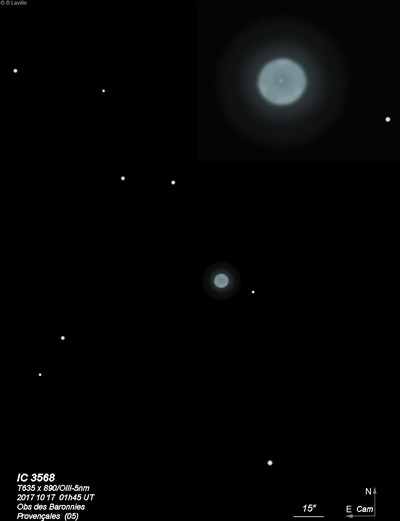
Robert G. Aitken discovered IC 3568 visually on 31 Aug 1900 while examining comet Borrelly-Brooks with the 12-inch refractor at Lick Observatory. The next night he examined it with the 36-inch and found a nebulous star or planetary with a mag 10.5-11 central star (BD +83°.357) within a 5"-6" halo. He noted it formed a 14.8" double (A 9001) with a mag 13 star. This object is Aiten's only discovery in the IC.
Based on Crossley photographs at Lick, Curtis (1918) reported "the nucleus is surrounded by very bright matter in a disk 18" in diameter, apparently perfectly round, and fading out a little at the edges."
In the 1956 book "Gaseous Nebulae", Lawrence Aller stated the "theoretician's planetary nebula" was most closely approximated by IC 3568. The 1987 study "The shapes and shaping of the planetary nebulae IC 3568, NGC 40, and NGC 6543" by Balick et al adds "If IC 3568 did not exist, it might have been created by theoreticians".
Brian Skiff notes the UGC misidentification (UGC 7731) as a galaxy. The UGC description is "Compact or *" and description "alm compl stellar on PA prints, prob extr compact gx." Because of the misclassification in UGC, this planetary is has the galaxy designation PGC 41662, though HyperLeda now shows the object type as a planetary.
200/250mm - 8" just non-stellar at 100x, definite disc seen at 165x. This planetary can take high power due to its high surface brightness.
300/350mm - 13.1" bright, small, round, high surface brightness disc 15" diameter. A mag 13.5 star is almost in contact at the west edge 15" from the center.
400/500mm - 17.5" (5/15/99): at 220x unfiltered, appears as a very small, high surface brightness disc, ~10" diameter with a mag 13.5-14 star close off the west edge. At 380x, the disc is concentrated to a quasi-stellar nucleus, but it was difficult to distinguish the central star due to the high surface brightness glow. Surrounding the central region is a much fainter, round, outer shell that increases the diameter to 15"-20". Seeing not steady enough for higher power.
900/1200mm - 48" (11/1/13): at 488x unfiltered contains an extremely high surface brightness inner disc, ~8" diameter. The mag 13.5 central star was only occasionally visible in very soft seeing. A fairly bright halo increases the diameter 2.5 times to roughly 20". A mag 13 star is just off the west side, ~15" from center (forms the double A 9001).
Notes by Steve Gottlieb
NGC 1961
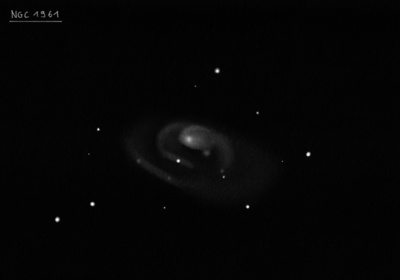
200/250mm - 8" (10/13/81): faint, moderately large, bright core, diffuse, elongated, star involved.
400/500mm - 17.5" (12/8/90): moderately bright, moderately large, elongated 2:1 E-W, weak concentration, small bright core. A mag 13 star is 30" SSE of center and a mag 12 star is just off the west edge, 2.4' from center. There appears to be a dark patch between this star and the core. Forms a pair with CGCG 329-011 7.6' NE (not seen).
600/800mm - 24" (2/18/20): at 375x; fairly bright, very large, elongated 5:3 ~E-W, contains a bright elongated nucleus that is oddly offset towards the north side. The halo has a low, but uneven surface brightness (due to spiral arms and dust) and extends nearly 3.5'x2.0', though it fades imperceptibly into the sky. A mag 13.5 star is superimposed 30" SSE of center. CGCG 329-011, located 8' NE, appeared very faint, small, round, 20" diameter, low surface brightness. A mag 15.3 star is 20" S.
900/1200mm - 48" (10/23/11): at 375x, this distorted spiral appeared very bright, very large oval nearly 2:1 E-W, ~3.6'x2.0', highly asymmetric appearance. Contains a very bright, large oval core that is clearly offset to the north side of the galaxy! A large arm sweeps E-W along the south side of the halo. A broad dust lane runs parallel to the arm on the inside. Surrounding the core are shorter inner spiral arms including an arm just north of the core that sweeps west and bends south. A mag 13.5 star is superimposed just inside the dust lane, 30" SSE of center.
Notes by Steve Gottlieb
NGC 2366
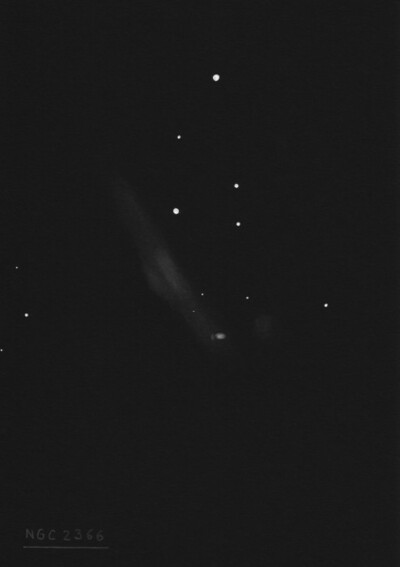
William Herschel discovered NGC 2366 = H III-748 on 3 Dec 1788 (sweep 889) and called it "vF, vS, stellar. 300 confirmed it and showed a vF branch to the nf." His description and position matches the prominent HII region at the southwest end of the galaxy. The "vf branch nf" refers to the actual galaxy. So, NGC 2366 applies to the HII region (also known as Mrk 71) as well as the galaxy. Modern sources misidentify the large HII knot as NGC 2363. See historical comments for NGC 2363.
Ralph Copeland described it on 9 Mar 1874 with the 72" as a "diffused neby preceding, pos 265.9°, dist 71.4" Neb * or neb knot post 318°, dist 77.6". The object has a curved tail, pos 30.9°, convex on the following side, traced 9' or 10'. The neb knot preceding is connected with the principal enbulosity. Line of stars spp, curved towards preceding side, nebulous? At least the enbula appears to extend so far on spp side. [See Pl I.]."
300/350mm - 13.1" (1/11/86): fairly faint, very large, elongated 5:2 SW-NE, low almost even surface brightness. An unusually bright HII region is at the SW end of the galaxy (2' from the center) and appears as a "fuzzy" 12th magnitude star. Although very small, it appeared elongated SW-NE and similar to a poorly resolved double star. Definite contrast gain with OIII filter.
400/500mm - 18" (3/19/04): at the SW end of the galaxy is a very bright knot (HII region), roughly mag 12.5 and perhaps 15" in size which responds to a UHC filter at 160x! At 323x this knot is irregular in shape (~20"x15", SW-NE) and brightness and at moments resolves into two or three components. The galaxy itself is fairly faint, large, and very elongated SSW-NNE, 3.5'x1.0', with a low surface brightness.
900/1200mm - 48" (4/15/10): The most striking feature of NGC 2366 is a prominent double knot (giant HII/starburst complex) at the SW end (also known as Mrk 71 amd NGC 2366-I). At 330x, the knot appeared very bright, elongated 3:2 E-W, ~18"x12", with two overlapping components (super star clusters A and B). A fainter and smaller knot (NGC 2366-II) was easily visible 15" E, for a total of 3 HII knots.
NGC 2363, a low surface brightness companion or detached OB association/HII region, lies 1.2' W of the bright double knot. At 330x it appeared fairly faint, moderately large, elongated 2:1 or 5:2 SW-NE, with a low but irregular surface brightness.
Notes by Steve Gottlieb
NGC 2715
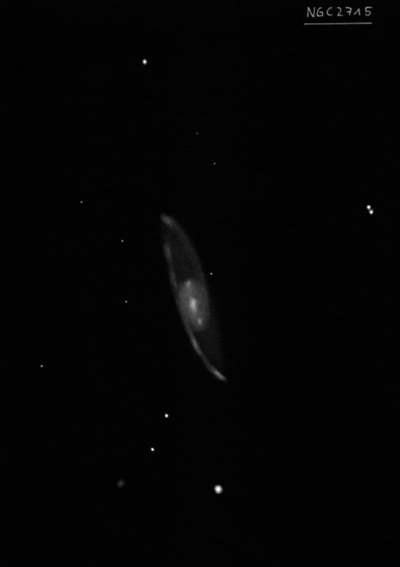
Alphonse Borrelly discovered NGC 2715 around 1871 with a 7.2-inch comet-seeker at Marseille Observatory. He noted "pretty bright, 3' in extent, elliptic; no nucleus." and his micrometric position (MNRAS, 32, 248) matches UGC 4759.
400/500mm - 17.5" (2/1/92): moderately bright, fairly large, elongated 2:1 SW-NE, 4'x2', broad weak concentration, fairly low but irregular surface brightness. The major axis is collinear with a mag 11 star 4.0' SSW of center.
Notes by Steve Gottlieb
NGC 1560
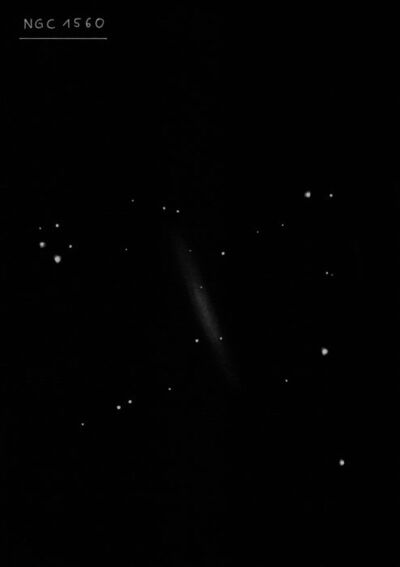
Wilhelm Tempel discovered NGC 1560 = T IX-1 on 1 Aug 1883 with an 11" refractor at the Arcetri Observatory. His position is 1 min of RA preceding UGC 3060 = PGC 15488, though at this high declination this amounts to 5'. UGC 3060 is misidentified as IC 2062 in RC2, UGC and CGCG. According to Harold Corwin, IC 2062 is a faint star found by Guillaume Bigourdan on the same night he observed NGC 1560.
200/250mm - 8" (1/1/84): very faint, fairly large, edge-on SSW-NNE, low even surface brightness. Appears as a ghostly streak.
400/500mm - 17.5" (2/20/95): fairly faint, very large, 6'x1', low surface brightness edge-on SSW-NNE. Broad weak concentration with no distinct core but there a central 2' brightening. A mag 13 star is embedded on the preceding side of the NNE extension. The galaxy appears to extend very faintly beyond this towards a mag 12 star further north. Another mag 13 star is superimposed at the SSW end and a brighter mag 11.5 star is just following the tip of this extension. Member of the IC 342/Maffei I group, a nearby but obscured group of galaxies.
Notes by Steve Gottlieb
NGC 1530
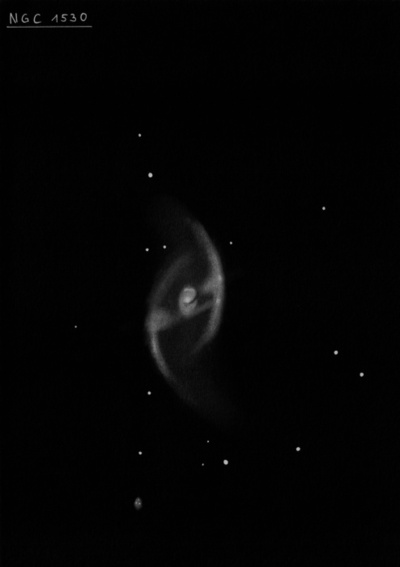
Wilhelm Tempel discovered NGC 1530 = T I-15 in 1876 with an 11" refractor at the Arcetri Observatory and included in the GC Supplement (GCS 5334). His matches UGC 3013 = PGC 15018.
300/350mm - 13.1" (1/18/85): fairly faint, fairly large, very diffuse, almost round, gradual weak concentration, no nucleus.
600/800mm - 24" (12/28/13): at 200x, appeared fairly bright, large, elongated nearly 3:2 N-S, ~3.5'x2.2'. Contains a large, brighter circular core within a very large, elongated halo. A low contrast, thin spiral arm is attached on the west side of the core and sweeps north at the edge of the halo and a similar enhancement is visible on the east side extending due south. Two mag 15 stars [22" separation] are superimposed on the NE side [1.1' from center] and a mag 12.8 star lies 2.5' N.
900/1200mm - 48" (10/29/16): at 488x; bright showpiece barred spiral! A relatively wide, very prominent bar extends WNW-ENE [PA 122?] and is steeply inclined to the orientation of the core. The bright core, centered on the bar, is elongated N-S and contains a very bright round nucleus that increases to the center. Two relatively bright and very distinctive thin spiral arms extend from the ends of the bar. The western arm is brightest in a region near the root, where it attaches to the bar and contains a small knot. The spiral arm is mostly visible extending north ~1.5' and only slightly curving east. A short, low contrast section of the arm extends south of the bar. A second long thin arm nearly perpendicular to the bar extends south a similar 1.5'. It is also brightest at its origin on the east end of the bar. The arm only extends a short distance and blends into the low surface brightness glow of the halo on the north side. From north to south tips of the arms is at least 3'. Two mag 15 stars are at the NE edge and a collinear mag 15.5 star is off the NW arm.
Notes by Steve Gottlieb
NGC 2523
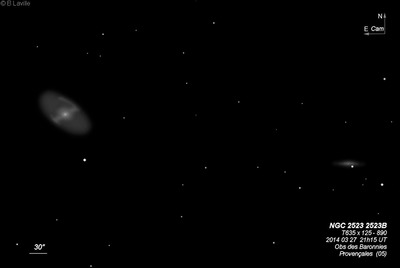
Edward Swift, Lewis' 14 year-old son, discovered NGC 2523 = Sw. II-32 on 7 Sep 1885 with the 16" refractor at the Warner Observatory. The Swifts' position and description ("pB, pL, lE, lbM, * nr") is a good match with UGC 4271 = Arp 9. This is the brightest galaxy (of 23) that Edward discovered.
400/500mm - 17.5" (2/8/91): moderately bright, elongated 3:2 SW-NE, fairly small. A center contains a bright central bar with a small bright core. A mag 11.5 is off the SW edge 1.5' from the center. Forms a pair with NGC 2523B = UGC 4271 9' W and NGC 2523C = UGC 4290 lies 20' SE.
900/1200mm - 48" (4/21/17 and 5/1/19): at 488x; bright, very large, showpiece barred spiral! Superb view with a strong bar running ~5:1 WNW-ESE, highlighted by an intensely brighter nucleus. Inner spiral arms are attached at the ends of the bar and form a gorgeous 360° inner circular ring! The region inside the ring is darker on both sides (southwest and northeast) of the bar. With averted vision a fainter outer halo extended mostly SW and NE, though I couldn't trace arm structure in the halo. A mag 11.7 star is 1.7' SW of center. Brightest in a group with NGC 2523B 9' W, UGC 4279 7' NE and NGC 2523C 19' SE.
NGC 2523B: moderately bright, fairly small, elongated 5:2 E-W, 40"x15", very faint outer extensions. A mag 14 star is at the southwest edge of the core. A mag 12.4 star is 1.2' SW. UGC 4279: extremely to very faint, thin ghostly streak 0.4'x0.1'. This is the brighter central bar and the extremely low surface brightness arms or halo was not seen. Situated 7' NE of NGC 2523 and 2.5' S of mag 8.2 SAO 6469. I needed to keep the bright star out of the field to glimpse this galaxy.
NGC 2523C: fairly bright, moderately large, very elongated 3:1 E-W, ~60"x20", well concentrated with an elongated bright core and small brighter nucleus. Located 20' SE of NGC 2523 and 10' WSW of mag 8.4 HD 68744. LEDA 213458 lies 2.8' NW. The companion (missing from Megastar) appeared fairly faint, fairly small, slightly elongated, brighter core, 18" diameter.
Notes by Steve Gottlieb
NGC 2633
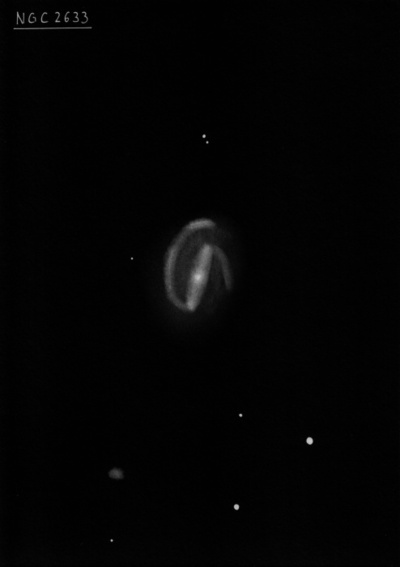
Wilhelm Tempel discovered NGC 2633 = T VI-5 = T IX-6 on 11 Aug 1882, along with NGC 2634. His position (corrected in list IX) matches UGC 4574 = Arp 80 = PGC 24723.
300/350mm - 13.1" (1/11/86): fairly faint, small bright core with faint extensions slightly elongated N-S. Forms a pair with NGC 2634 8.2' S.
900/1200mm - 48" (3/1/19): Excellent, fairly large, two-armed barred spiral! The central part of the galaxy consists of a very prominent bar oriented ~3:1 NNW-SSE, with a very bright core. A striking spiral arm is attached at the south end of the bar. It bends sharply clockwise and extends north, on the east side of bar, arcing gently with a length of ~1.5'. This arm has a well defined inner and outer edge and is separated from the bar by a dark gap. As the arm extends north it fades but at the northern end bends sharply west [1.0' N of center] and noticeably brightens in an elongated piece [consisting of multiple HII regions on images]. At the north end of the bar a second arm emerges towards the west and starts to curl south, but fades and dims, reaching no further south than the center of the bar.
Notes by Steve Gottlieb
UGC 3730
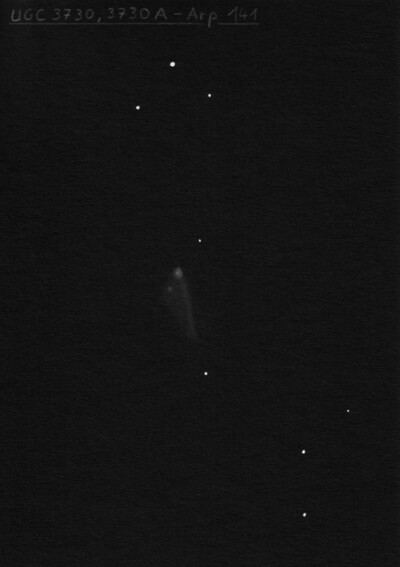
600/800mm - 24" (1/25/14): at 375x, VV 123B appeared moderately bright, small, round, compact, 20" diameter, high surface brightness. VV 123A, situated just 25" S (nucleus of the Ring component) was cleanly resolved and appeared very faint, very small, round, 12" diameter, low surface brightness. The actual ring, extending south, was not seen.
900/1200mm - 48" (4/6/13): Arp 141 is an unusual interacting system, listed as a Ring galaxy with collider in Madore, Nelson and Petrillo's 2009 "Atlas and Catalog of Collisional Ring Galaxies". At the north end is VV 123B = Madore C1 (collider), which appeared bright, fairly small, round, 20" diameter, sharply concentrated with a very bright nucleus. This is the brightest component in the system. At the south edge of VV 123B (25" S of center) is VV 123A = Madore RN (Ring nucleus), which appeared fairly faint, small, irregularly round, 15" diameter. The ring component extends south of VV 123A and appeared as a faint, moderately large, oval haze, ~60"x30", mostly evident as a brighter arc or tail along the west side. This arc extends about as far south as a mag 14 star which is 1.5' SSW of VV 123B, though VV 123C, a small knot at the south end, was not resolved. Viewed at 488x and 610x.
Notes by Steve Gottlieb
IC 391
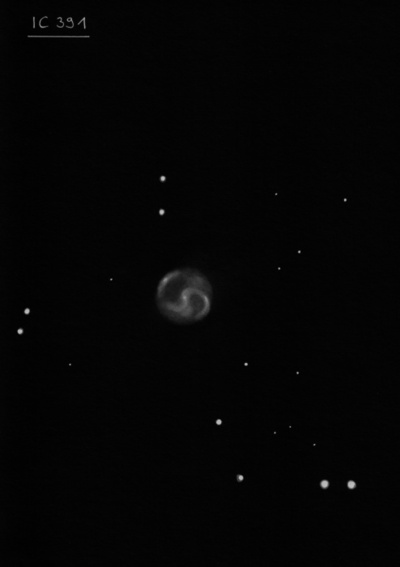
William Denning discovered IC 391 on 7 Nov 1890 with his 10-inch With-Browning reflector from England. He simply noted "F, S, R." and measured a fairly accurate position.
400/500mm - 17.5" (3/1/03): easily swept up at 100x; fairly faint, moderately large, round, fairly even surface brightness. At 220x, embedded in the middle of a scattered group of stars, 1' diameter, nearly uniform surface brightness, possibly slightly elongated ~E-W, 1.0'x0.9'.
Notes by Steve Gottlieb
NGC 2363
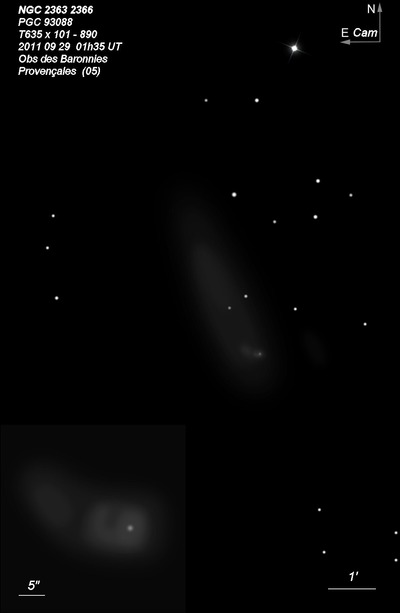
A 2010 study suggests NGC 2363 was very close to the southern tip of NGC 2366 less than 10 Myr ago, and could have triggered the interaction which has led to the strong episodes of star formation in the southern half of NGC 2366 as well as this galaxy.
Ralph Copeland discovered NGC 2363 on 9 Mar 1874 with the 72" while observing NGC 2366 = H III-748. He noted a "diffused nebulosity preceding, pos. 265.9°, dist 71.4"." Copeland's offsets were measured with respect to the unusually bright HII knot at the southwest end of the galaxy, which has always been assumed to be NGC 2363. But Copeland's "diffused nebulosity preceding" refers to UGC 3847, a separate galaxy ( or isolated star cloud) just west of the southwest end of NGC 2366.
CGCG misidentifies NGC 2363 as the "bright emission patch at the SW end of NGC 2366" and RNGC misclassifies NGC 2363 as nonexistent with the comment "Patch in NGC 2366, Zwicky". See Harold Corwin's identification notes for the complete story.
900/1200mm - 48" (4/15/10): NGC 2363 is either a small satellite galaxy of NGC 2366 or possibly a detached star cloud or galaxy west of the southwest end of NGC 2366. At 330x, NGC 2363 appeared fairly faint, moderately large, elongated 2:1 or 5:2 SW-NE, with a low but irregular surface brightness. Located ~2.2' SW of the center of NGC 2366 and 1.2' W of the bright knot. The bright HII knot/starburst region in NGC 2366 is often misidentified as NGC 2363.
Notes by Steve Gottlieb
IC 2184
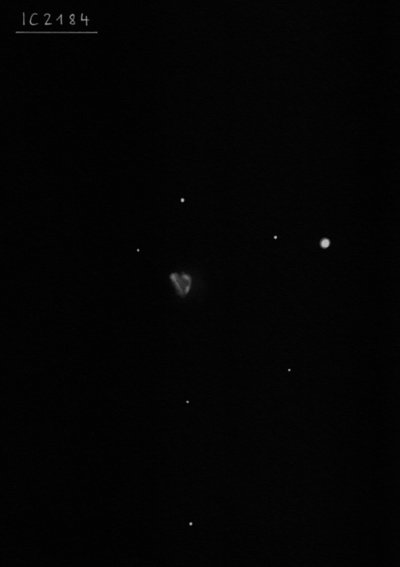
CGCG calls this object a "Triple system"; UGC says "double or triple"; Mrk says "two doubles"; Zwicky described it as a "blue post-eruptive quadruple of two bar-shaped and two spherical compacts" and V-V called it a "nest of six compact galaxies". HST image shows two interacting galaxies, both with starburst regions.
Guillaume Bigourdan discovered IC 2184 = Big. 390 on 24 Jan 1900. The IC position is nearly 11' too far southeast. Corwin re-reduced his original offsets, though, and they match this multiple system. CGCG (330-039) doesn't associate the IC identification.
600/800mm - 24" (2/5/13): at 375x, fairly faint, fairly small, irregularly round, ~25"x20", irregular surface brightness but no resolution into components. Perhaps higher power is needed to see the two main components.
Notes by Steve Gottlieb
M 2-2
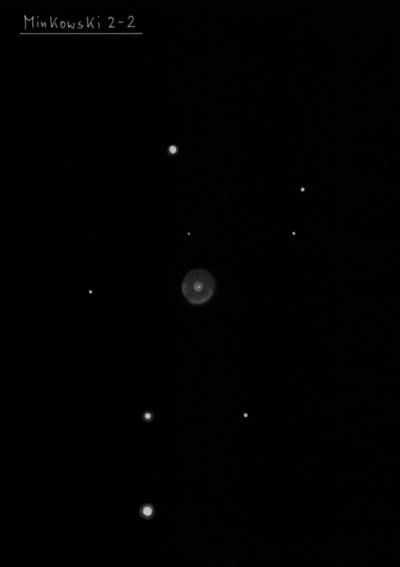
| Type | PN |
| RA | 04:13:15.0 |
| Dec | +56:56:58.0 |
| major_axis | 6.0'' |
| mag | 13.7 |
| surface_bright | 8.4 |
